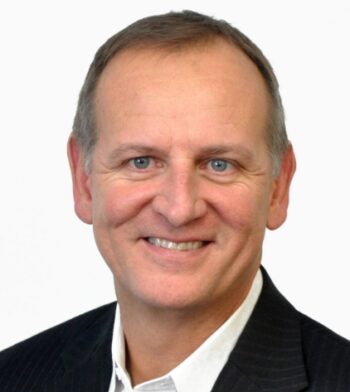I recently had the distinct pleasure of sitting down with Pete Doyon, Vice President of Product Management at Schleuniger Inc. Having found out Pete had set a retirement date, I was eager to hear his story after many years with the company. What I discovered was that Pete’s story was very much that of Schleuniger Inc. in the USA.
Pete started off as an electrician working on controls and alternative energy (before it was cool) and got into wire processing in 1983. “My brother-in-law owned a rep group in New England called Burns Associates and they represented Eubanks and Cablescan. Their field service engineer left, and he asked if I knew anybody interested. I said, ‘yeah, me!’” Pete jumped right in and they operated that way for several years.
In the mid 1980’s, the team was at a trade show in Europe where they saw a new machine by a company called Schleuniger. It was the first programmable coaxial cable stripper to come on the market and they were duly impressed. “We approached Dr. Schleuniger about distributing the machine in North America. He said he already had an arrangement, and we couldn’t change his mind,” Pete lamented. They hired a patent attorney to do a search and there was no patent on the equipment, so they made the decision to develop and market their own programmable coaxial cable stripper.
As the Schleuniger patents began to emerge, Burns Associates had to keep changing their design to get around the claims. It got to the point where Dr. Schleuniger was threatening to sue them. In a textbook example of turning a problem into an opportunity, the team again approached Dr. Schleuniger about creating a US based company engaged exclusively in the distribution and further development of his equipment. They already had a rep network set up for their original machines, and by now had gained a lot of knowledge of the North American market. “Dr. Schleuniger agreed,” Pete said, “and so, starting on January 1, 1988, we became Schleuniger USA Inc.”
They hit the ground running with only three products. By mid 1988, they were manufacturing one of the coaxial cable stripping machines at their headquarters in Manchester NH. “We were developing new products in Switzerland and in Manchester NH, so it was really an exciting time,” Pete remembered. But with only two sizes of the coaxial cable stripping machines and one small wire stripper, they knew their offering should grow. “Around 1990, we decided we needed a cut and strip machine. It would have taken too long to develop our own, so we found a company called Adola AG who actually had a machine we could private label. We called it the CS 9000 and we were in the cut and strip business.”
At some point, they discovered that Adola was not the actual manufacturer of the machine. It was actually being built by a company called Sutter Electronic AG, another Swiss company. “We went directly to Sutter and said, ‘hey, can you make the next generation machine for us?’” So, in 1991 they launched the CS 9100. “It was unique because not only did it have a programmable feed system, but it also had an indexing cutter head, so you could mount a second set of blades. So, for military and aerospace applications, you could have die blades or radius blades in the second blade position. It was unique to the market and took off like a rocket.”
Also, in 1991, Sutter Electronic AG was purchased by Dr. Gerhard Jansen and Martin Strehl. In another twist of events, Sutter Electronic AG made a deal to acquire Schleuniger Productronic AG in 1993. Instead of renaming the newly formed company to Sutter, Dr. Jansen and the management team realized Schleuniger had already established a strong identity in the market and decided to keep the name. “It was kind of a surprise because our vendor actually bought the company from Dr. Schleuniger.”
Pete maintained that Dr. Jansen and Martin Strehl and later Marc Amiet, were instrumental in the growth that occurred in the period following. “Especially here in North America with us as the locomotive telling them, ‘ok, this is what we need next’. We had a great team of engineers in Switzerland, both software and hardware folks, so we were able to go out and sell and figure out what the market needed.”
Growth continued, not only through market share penetration, but also through acquisition. Dr. Jansen wanted to round out the company, so they acquired Kirsten AG, who made crimping presses, Grote & Hartmann Engineering GmbH, who produced crimp x crimp machines and PAWO Systems AG, who produced seal loading machines and cable assembly automation lines. In 2012, Schleuniger acquired a minority stake in DiIT Ltd., a leading MES software provider. All along the way, they kept growing with more and more acquisitions as well as organic growth.
As you can imagine, Pete wore many hats along the way. In the beginning, he did everything from manufacturing and design engineering to purchasing, assembly, shipping / receiving, product support, service, or whatever was needed. “I did everything but accounting because that just didn’t look like fun.”
I asked Pete what surprised him the most along the way. “Probably the biggest thing was that we rose so quickly to either number one or number two in a lot of different product categories. As far as benchtop wire processors, we rose to number one very quickly. And eventually with the large crimp x crimp machines, we rose to number two, with Komax being the leader. The players before us were Artos, Eubanks, and Carpenter, so for us to come out of nowhere and take significant market share was really a surprise.”
When I asked how Schleuniger achieved this growth, he quickly pointed to the company’s creativity and innovation. “We were perceived as a premium offering, being a Swiss company. Switzerland is not the cheapest place in the world to manufacture products. So, the equipment wasn’t cheap, but we had a good name in terms of longevity and precision.” Pete also feels a key to their success was the ability to focus on special applications that nobody else could do. “We came out with a semi-rigid cable stripper, and nobody else had a programmable machine for that. We came out with a fiber optic cable stripper that could strip the jacket, cut the Kevlar and strip down to the bare glass. Nobody else had that when we came out with it.”
As important as the products have been, Pete is probably most proud of his team and the relationships they have built through the years. “We started with a lot of mom-and-pop shops. You get to know them with that first cutting or stripping machine. You take care of them and they love that machine. That relationship just closes the door on the competition as the customer grows.”
Pete spoke of the industry partnerships they have had through the years. He agreed with my own assessment that while other companies tend to hold their cards too close, Schleuniger has always sought to establish formal and informal ties with those marketing complimentary products. “Probably one of the first ones we worked with was Cirris Test Systems, and we recently acquired them,” he noted. Schleuniger has also hosted trade events like their Oktoberfest themed event with Panduit, Telsonic Ultrasonics, Gem Gravure and other industry players. “Sure, you have the equipment in the demo room and the salespeople, but I think it was always more about getting together and having fun and I think customers really appreciate that.”
Pete has seen the industry itself develop through the years as their core customers processed smaller and smaller wire, then back up to larger size cables for EVs. “These high-voltage cables go up to 120 mm² and we offer solutions for processing these types of cables with our PowerStrip and MegaStrip machines. We’ve also developed a fully automated HV cable processing line called the Transfer Line Family S70. We’re shipping those now and it’s just amazing technology.”
Pete affirmed staffing concerns play a big role in equipment development these days, but that other factors are actually driving automation. “Yes, there are labor shortages, but the OEMs really don’t want our customers making anything where the operators can affect the product quality. They want to have consistency so they are pushing suppliers to provide as much automation as they can. They may have tolerances +/- .1 mm, and you just aren’t going to do that manually.”
With Pete retiring, that leaves some pretty big shoes to fill at Schleuniger. It should be no surprise that Rob Boyd has been chosen to step into a major part of Pete’s role. “We have announced that Rob will be stepping in as Head of Product Management at Schleuniger Inc. He recently sat in on his first management committee meeting, so he got to see what he’s been missing all these years. Rob is just great. I hired him away from Komax about 22 years ago, so it’s kind of funny that Schleuniger and Komax are coming together now.”
Speaking of Komax, Pete sees nothing but positive outcomes with the combination. “We are really pleased with the management at Komax and we are taking things one step at a time, trying to figure out what makes the most sense. Right now, we are still continuing with the Schleuniger brand and the Komax brand. It’s kind of business as usual, but we are always looking forward to what makes the most sense with our R&D budgets, and what each company should be developing. We’re not working against each other anymore. We are working together and I’m very pleased with how that is going. It’s interesting how it all started, and how it all ended up now with Komax and Schleuniger together. It’s been a fun and incredible ride. It was a crazy start but it’s probably one of the best things that ever happened to me and also the folks who work here in Manchester.”
We chatted a bit about Pete’s plans for retirement. It has always been a dream of his to retire early and enjoy his favorite outdoor activities like golfing, hiking, fishing and skiing. “Those are the things you don’t have time for when you’re working around the clock. I also intend to create my own honey-do list. My wife is a bit concerned I might be home too often.”
We at Wiring Harness News wish Pete the very best in his retirement. His hard work and dedication to the industry are unparalleled. We will miss him at the shows but appreciate the contributions he has made to the wire harness industry.
































































